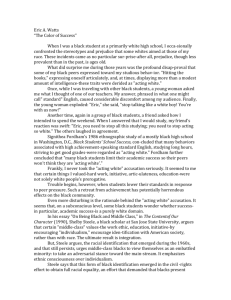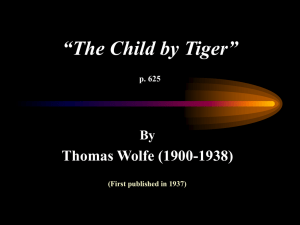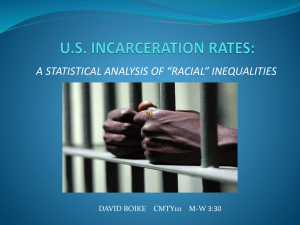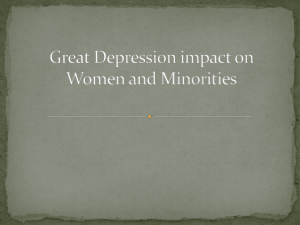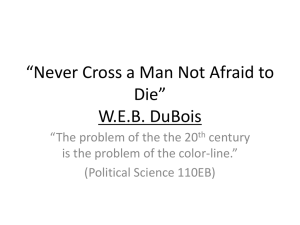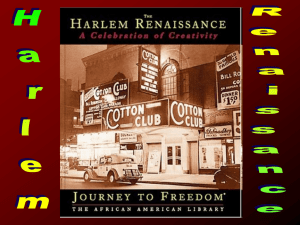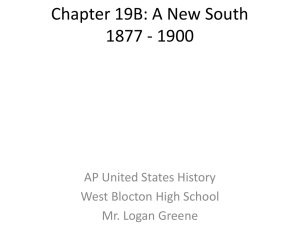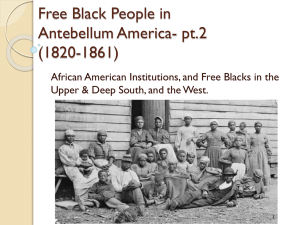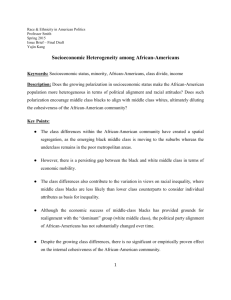Free Black People in Antebellum America (1820-1861)
advertisement
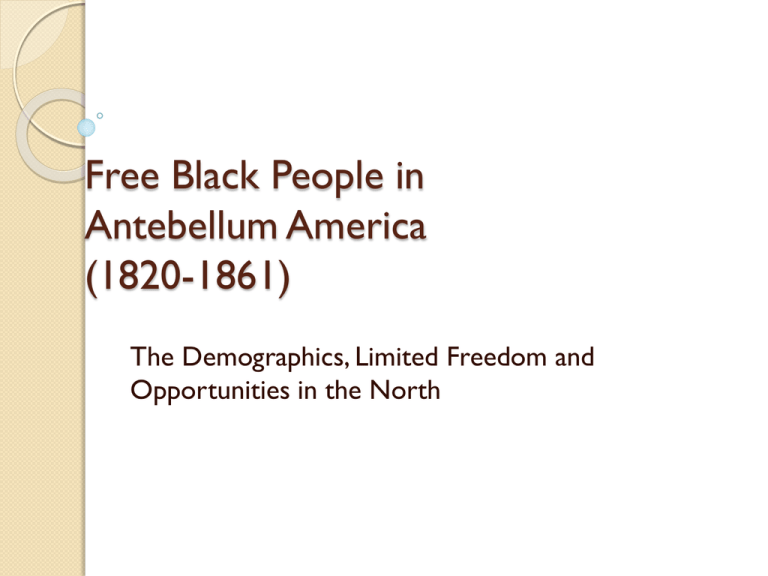
Free Black People in Antebellum America (1820-1861) The Demographics, Limited Freedom and Opportunities in the North Demographics of Freedom Free Blacks in 1820: 2.4% of U.S. pop. and 3% of Southern pop. Free Blacks in 1860: 1.6% of U.S. pop. and 2.1% of Southern pop. This decline in population percentage for free blacks was attributed to the massive white migration to the United States in the middle to late 19th century. In larger cities, there was a higher concentration of African Americans. Baltimore: 12% population Philadelphia: 4.2% population (22,185) The Jacksonian Era The War of 1812 led to drastic changes in the U.S. 1) Market Revolution in the north commercial farming, factory production, and national markets 2) Transportation Improvements turnpikes & canals link the nation and railroads connect urban to rural. These two impacts, along with the expansion of cities, led to a large urban class which shifted the social order. Universal male suffrage was also a major shift during this time and this led to a change in the political trends of the time. Andrew Jackson became president in 1828 for the Democratic party. He was a slaveholder that promoted states’ rights, economic localism, and the expansion of slavery. Limited Freedom in the North The Fugitive Slave Law of 1793 extended the power of southern masters into northern states. This ensured that escaped slaves could be seized and returned to their former masters. Whites who aided fugitive slaves would be fined and/or jailed. But no one was safe under this law. Frequently free blacks in the north were kidnapped and brought down south into a life of slavery. Black Laws Also during this time came the belief that each ethnic and racial group had its own inherent spirit. This came out of the Romantic Age of the 1800’s. Whites viewed themselves as self-reliant, intellectually curious, and capable of selfgoverning. Blacks were viewed as incapable of honest work, posed competition for jobs and corrupted. Many believed that southerners had been degraded through their interactions with blacks and laws were established in several northern states to prohibit black settlement. Ohio: legal evidence of free status and $500 bond paid. Illinois: black settlers would be whipped unless they leave. Indiana: ratified constitution banning blacks (MI, IO, WI) Fortunately these laws were rarely enforced and many tolerated low populations of free blacks. Disenfranchisement Blacks were denied the right to vote in most of the north (except N.E.) ◦ The Old Northwest would not allow blacks to vote prior to the Civil War. ◦ Older northern states had allowed voting rights, but the Jacksonian democracy attempted to disrupt this practice. Reasons for Opposition: ◦ ◦ ◦ ◦ Blacks would be elected to office. Blacks would corrupt the political process. Blacks would mix socially with whites. Angry whites would react violently. Disenfranchisement in States New Jersey: No black voters (1807) and white only suffrage provision (1844) Connecticut: No new black voters allowed. Maine, Vermont, New Hampshire, and Massachusetts did not take measures to deny black suffrage. Rhode Island: No black suffrage (1822) and universal suffrage (1842) New York: Raised property qualifications for blacks (1821) Segregation All northern blacks felt the effects of segregation. Hotels, taverns, and resorts banned blacks unless they were a servant for the whites attending. Blacks were banned from lecture halls, art exhibits, and religious revivals– or they had to attend at different times then whites. Steamboats allowed for black passengers, but they could not rent cabins and would have to remain on deck (even in storms and at night). They also had segregated cars on railroads, such as the “Jim Crow,” cars in Massachusetts. Distrust of whites was prevalent in the north, and this was due to the hypocrisy blacks felt in day to day life. Segregated black cities were safe from discrimination, but slum-like. These included: “Nigger Hill” (Boston), “Little Africa” (Cincinnati), “Hayti” (Pittsburg), and “Southside” (Philadelphia) Black Communities in the Urban North Urban neighborhoods nurtured black community life, and many had developed from the emerging free black communities. These communities were characterized by resilient families, poverty, class divisions, active church congregations, voluntary organizations, and a concern for education. The Black Family Northern blacks established their own households in the early 19th century. Average black family in northern cities had two parents and two to four children. Northeast and Old Northwest developed a trend of single parent families. This trend may have been due to low employment opportunities for black males, as well as the high mortality rate. Many families took in boarders to help pay bills. The Struggle for Employment The flood of European immigrants in the 19th century caused skilled black laborers to suffer. White workers also excluded blacks from apprenticeships, refused to work with blacks, and violently protested the hiring of blacks when whites were unemployed. Irish immigrants especially hurt the black opportunities in the north. Only 0.5% of black workers had factory jobs. 80% of women washed clothes and were domestic servants. Many black males found employment as sailors, and by 1850 they made up 50% of merchant and whaling vessels crews. The Northern Black Elite Black elite emerged between 1800-1860. Talent, wealth, occupation, family connections, complexion, and education. Led in the development of black institutions and culture, antislavery movements, and the struggle of racial injustice. Physicians, lawyers, ministers, and undertakers would cater to an exclusively black clientele in segregated neighborhoods. Complexion played an interesting role: ◦ Whites were more likely to hire someone of “mixed” race. ◦ Notions of “White beauty” influenced the bride choice at this time. Black Professionals James McCune Smith John S. Rock These professionals were examples of the black elite that emerged. Many worked without “degrees” since denied the right to higher education. Macon B. Allen Robert Morris Artists & Musicians Many black artists depicted scenes of slavery or used African American themes. Robert S. Duncanson & Edmonia Lewis Musicians did not enjoy the reputation of artists, but circles of musicians performed orchestra pieces in cities such as Philadelphia, New Orleans, Boston, Cleveland, New York, Baltimore, and St. Louis. Artwork by Robert S. Duncanson Black Authors The Antebellum period was considered a Golden Age for African American literature. The authors portrayed an America that had not lived up to its revolutionary ideals. Autobiographies recounted slave life and harrowing stories of escape.

